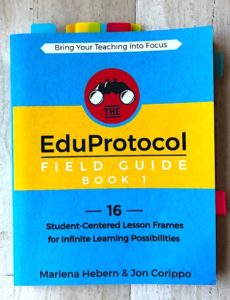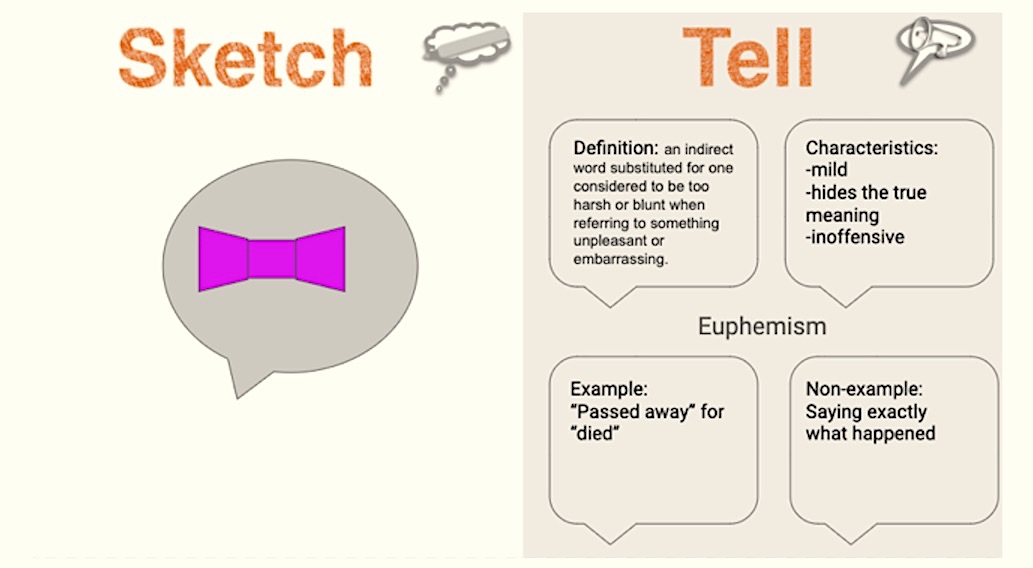Using ‘EduProtocols’ to Boost Virtual Learning
A MiddleWeb Blog
 One goal I had for the year was to put into practice many of the ideas that I’d highlighted in professional development books in the past – only to put them on a shelf to gather dust.
One goal I had for the year was to put into practice many of the ideas that I’d highlighted in professional development books in the past – only to put them on a shelf to gather dust.
As we enter our second month of virtual learning, I’m so grateful that I decided to get back into The EduProtocol Field Guide by Marlena Hebern and Jon Corippo. Many of their activities translated easily into online practice, allowing me to create new routines for my classes.
In the words of the authors, “EduProtocols are instructional lesson frames that are designed to engage students in learning through critical thinking, collaboration, communication, and creativity.”
What I enjoy about these protocols is that I can use templates for a variety of topics, saving time in my shortened online classes. The authors are generous, linking many of their activities on the EduProtocols website for free.
I started with the 8 p*ARTS of Speech practice, in which students complete a Google Drawings document based on a humorous photo. They work together to apply the parts of speech, write a three-word sentence, and create a simile related to the image. I share the templates with them on Google Classroom, so I can observe their documents as they work, offering feedback.
One of the small joys of virtual learning has been popping into a breakout room and hearing students arguing over which interjection best fits with an image. My students enjoyed that they were able to express their mastery quickly and then play with the process, trying to use the most gruesome or humorous words to describe the image.
Once the class had mastered that task, we moved on to the Sentence Parts template, gradually adding boxes to the Google Drawing until students were correctly using semicolons, homophones, and possessive nouns every day.
This step took less than eight minutes of class time each day, and saved me so much time because students now understand when I say to them, “Use a plural possessive.” I have also seen more semicolons in independent student writing than I have with any other method of teaching.
In addition to using EduProtocols for grammar, I’ve incorporated Hebern and Corippo’s ideas into our Dystopian Unit vocabulary study. We started with the Frayer model, which uses boxes to break down a word into its definition, characteristics, an example, and a non-example. With 20 minutes less class time available during virtual learning, I provided the definition for the students.
When students became adept at the Frayer model, we moved on to the Sketch and Tell EduProtocol (shared on their site from from their second book). This takes the previous skill to the next level by requiring students to create an image using only the shape tools available in Google Drawings (no internet images).
I love that students need to be creative and discuss how to best represent abstract concepts with simple shapes. Their illustrations frequently surprise me, and they love to compete to see which team has the best image.
It can feel daunting to roll out a new activity at the end of the year when there are already so many new challenges involved in online teaching. Yet you could easily add any of these activities to your class tomorrow with very little stress. The second time we did the 8 pArts of speech, a student exclaimed, “Oh, I like doing this. It’s kind of fun!” I can’t ask for much more than that when it comes to teaching grammar online.
Where will the EduProtocols take me next? I hope to purchase the second book in the series and to reread the section on creating a classroom culture (sixty pages are devoted to starting the year right). This book would be an excellent gift for new teachers, but even after 17 years of teaching, I still found so much to inspire me.








































This is a timely article and very helpful! I always look forward to Ms.Kelly’s posts!
Thank you for sharing!
Thanks for the great post!!
The Eduprotocols engage students, and engagement has been problematic for most teachers, schools and districts in 2020. How do the protocols complement district curriculum and instruction? How is assessment and feedback built in or complement curriculum and lessons?
Hi Deb,
Thanks for commenting. The nice thing about Eduprotocols is that they are just a framework for you to put whatever content you need to teach. For example, my students need more practice with writing claims, so I will be using them for that in January.
I find it quick to flip through them to see who understands the content. You can even use it as a summative; the students will be comfortable with the format so the focus is on demonstrating their knowledge.
Thanks do much!